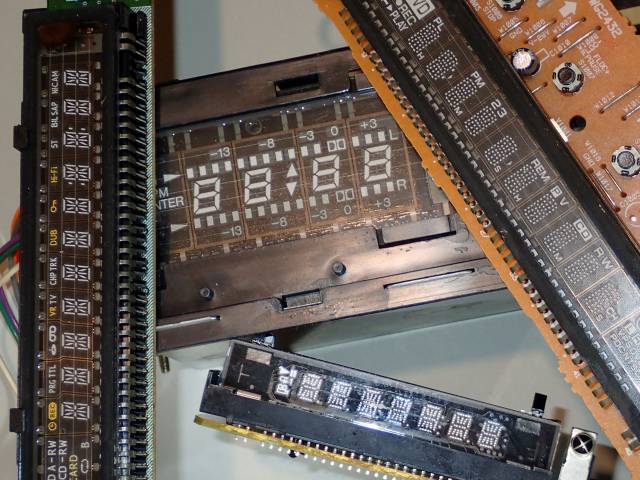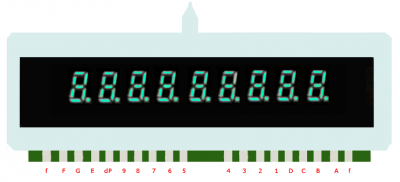User Tools
Site Tools
VFD module data
Published 9 May 2018
Reusing Vacuum Fluorescent Displays
I have a few old Vacuum Fluorescent Displays (VFDs) from old electronic equipment, such as CD players and microwave ovens, that I would like to use in projects.

Overview
CD playes, radios, alarm clocks and microwave ovens often contain VFDs. VFDs recovered from equipment are often mounted on their own circuit boards with driver ICs, but require additional power supplies beyond that used by logic circuits, to power their filaments and grids/anodes.
Hardware description
The fluorescent displays may contain 7 segment numerals, multi-segment alpha-numeric characters, or dot matrix characters as well as other custom symbols. Each element has a phosphor coated surface a glows when appropriately driven by the controller. Basically they are triode vacuum tubes with multiple sets of anode, cathode and grid/screen electrodes, plus a heater/filament to heat the cathode to cause it to emit electrons. Which numeral/character/symbol is selected is controlled by voltage on its grid. The individual anode element within a character is made to glow by applying a voltage to attract the stream of electrons to that anode.
The heater and cathode are electrically the same element which can cause some complication because of the voltage drop from one end of the heater to the other.
As with most multi-character displays the characters are multiplexed to minimise the number of pins needed to drive it, so each character is turned on and off rapidly in succession, to give the illusion of a steady display.
Recovered VFD modules
On the sidebar there is a list of VFD modules that I have recovered from various pieces of scrap equipment and the linked pages include pinouts etc.
References and Additional Resources
- https://hackaday.com/tag/vacuum-fluorescent-display Quick and Dirty Driver Tips for Surplus VFDs
- AN-378.pdf, A Novel Process for Vacuum Fluorescent (VF) Display Drivers.
- AN-440.pdf, New CMOS Vacuum Fluorescent Drivers Enable Three Chip System to Provide Intelligent Control of Dot Matrix VF Display. (COPS424C, MM58341, MM58348)
If any referenced page no longer exists, try looking for its URL on http://archive.org.
Manufacturers Websites
Futaba
Noritake-Itron
Samsung
ZEC Zhejiang Beijing Orient Vacuum Electronic Co. Ltd
Recycling
If looking for obsolete modules, try archived versions of the manufacturers website on http://archive.org.
Page Tools
 Except where otherwise noted, content on this wiki is licensed under the following license: CC Attribution-Share Alike 3.0 Unported
Except where otherwise noted, content on this wiki is licensed under the following license: CC Attribution-Share Alike 3.0 Unported